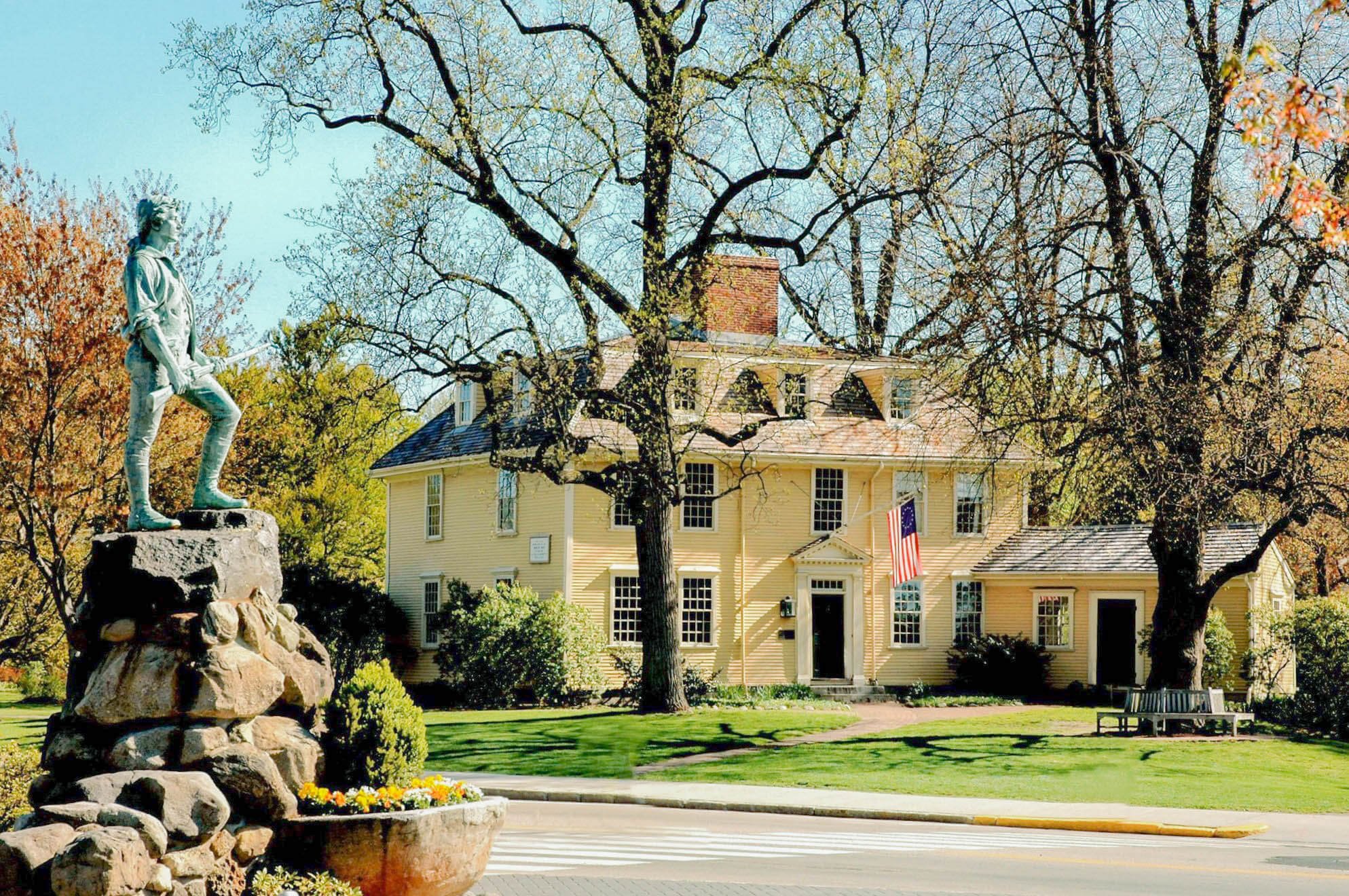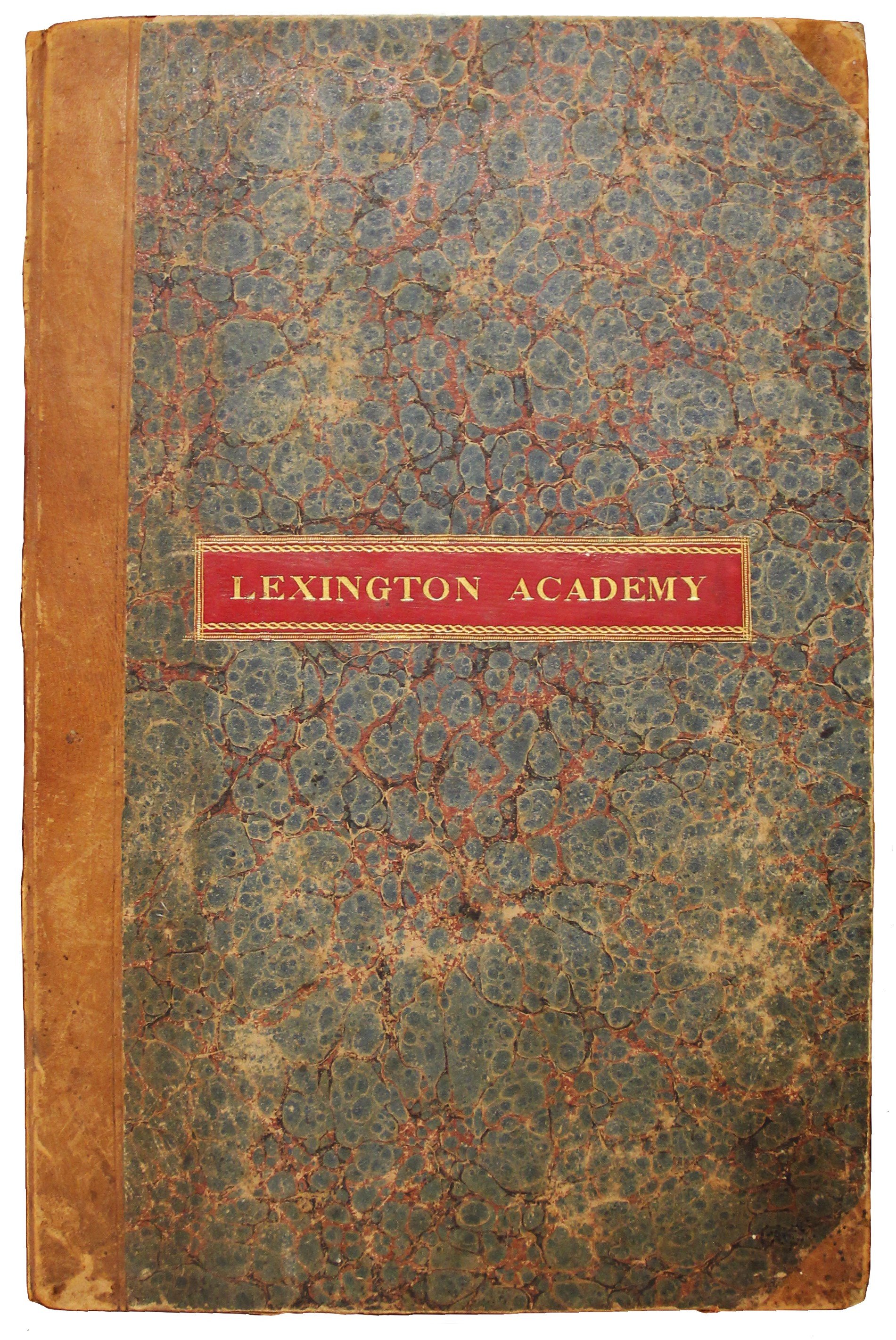
Lexington Academy
Lexington Historical Society hosts multiple exhibits each year in the front window of the CVS pharmacy at 1735 Massachusetts Avenue. Enjoy our current exhibit on Lexington Academy beginning January 9th.
Cary Memorial Library, Edward B. Worthen Collection Slide 21, colored by Ariel Cohen, 2023
Ledger of Lexington Academy records from 1823-1827. Lexington Historical Society, no.1503.
What was the academy movement?
Following the American Revolution, education was viewed as an important tool to shape citizens of the newly-established democracy. While states funded early education in small district schoolhouses—six of which existed in Lexington by the 1820s— options for a secondary education were limited despite high demand. To accommodate this need, the academy movement grew as communities in rural areas established private institutions, either as terminal schooling or – for men only – as preparation for a college education. Lexington Academy, located just off the historic Lexington Battle Green, was one such institution.
Who attended?
Students were mostly middle class; typically, their parents owned land but were not of incredible wealth.
Perhaps surprising to some, many of these academies were coeducational. At some institutions, more women attended than men!
Despite the seemingly progressive stance on coeducation, current research suggests that there were no people of color represented at the Lexington Academy. It is possible that as the Lexington Historical Society uncovers more names of Black residents and people of color who lived in Lexington during this time, we might gain additional insight into the demographics of the school.
What can documents tell us?
Lexington Historical Society owns a collection of historical documents that gives us insight into the daily life and operations of one of these institutions that grew out of the academy movement, the Lexington Academy, located just off the historic Lexington Battle Green in the town center.
Share certificate owned by Nathan Dudley, 1824. Lexington Historical Society no.901.
The Founding of Lexington Academy
On February 18th, 1822, the Governor of Massachusetts, John Brooks, approved an Act of the Legislature to establish Lexington Academy, outlining its aim of “promoting religion and morality, and for the education of youth in such of the liberal arts and sciences as the trustees for the time being shall direct.”
The act gave a Board of Trustees authority to govern the institution, many of whom were local prominent men whose children also attended. Some of whose names might be recognizable as those who had families on the Lexington Green on April, 19th, 1775.
.
Augustus, John
Chandler, William
Dudley, Nathan
Fiske, Doctor Joseph
Harrington, Jr., Nathaniel
Greenleaf, Thomas
Merriam, John P., Esq
Merriam, Rufus, Esq
Munroe, Jonathan
Munroe, Thomas
Reed, Christopher
Reed, Hammond
Reed, Nathan
Richardson, Aaron P.
Smith, Jr., William
Simonds, Ebenezer
Simonds, Joseph
Spaulding, Dr. Stilman
Tufts, Thomas
Wyman, Francis
As with many academies during this time, the Trustees owned shares of the Academy as a way to raise funds. The 1824 certificate shown above indicates that Nathan Dudley (1755-1835) purchased one share for one hundred dollars. Nathan’s daughter, Rebecca Dudley (1808-1853), attended school at the Lexington Academy.
What can this page of the tuition ledger tell us?
Tuition required: Attendance cost $4.50 or $5.50 for the eleven-week quarter. While existing Academy documents do not explain the dollar difference in tuition price, many academies charged different fees depending on the courses taken.
Tuition Exception: William Munroe “paid by taking care of school house.”
Episodic Attendance: Many students did not attend for the full eleven weeks, and did not attend terms sequentially. Students were required to balance their schooling with seasonal work, requiring nineteenth-century academies to be flexible.
Incidentals: Next to Nathan Simonds’s name is written, “1 desk lid” and next to that of Nath. Green, “1 pane glass broken—paid.”
Ledger listing tuition payments from 1823-1827. Lexington Historical Society, no.1503.
Rules and Regulations
What rules did students have to abide by at the Lexington Academy? This 1829 document from the last few years of the school’s existence gives us some insight into some of its values and priorities.
What about these rules surprises you? What might look similar to school rules today?
Rewards of Merit
What motivates(ed) you in school? Good grades? Praise from a teacher? Approval from classmates?
Elizabeth Whitcomb, listed as a student at the Lexington Academy at the same time that this award was granted, appears to have earned this paper token through “diligence and good behavior.”
These Rewards of Merit were commonly found in both 19th century schools and academies alike as a way to provide an incentive for good behavior using positive reinforcement.
The building reenvisioned as Old Hancock Church, early 1900s. Lexington Historical Society, no.10302
List of Lexington Academy regulations, November 1829. Lexington Historical Society no.802
Areas of Study
While it is unclear exactly what students studied at Lexington Academy, English and history books owned by one of the Academy’s earliest students and daughter of a Trustee, Elmira Reed, give us insight into at least two subjects taught at the school.
Although areas of instruction varied widely, many local academies taught both classical studies, offering Latin and Greek, as well as English studies, which included a curriculum of arithmetic, geography, English grammar, and literature.
Boarding
Unlike boarding academies that we might think of today, students did not reside on the Lexington Academy premises. Instead, students stayed with local families. This 1823 broadside (the 18th and 19th-century equivalent to a poster, announcing events to the public) notes where the Academy’s students resided within Lexington.
This type of boarding allowed the academies to be integrated within the local community. Bringing together students of similar age form a wide region also helped create important social networks.
Abby Ann Muzzey Brigham (1806-1870) later in life, 1860s. Lexington Historical Society no.2356.
Merit certificate for Elizabeth Whitcomb, October 21st 1824. Lexington Historical Society.
1823 broadside advertising Lexington Academy. Lexington Historical Society, no.900.
Post-Academy Life
A small selection of the boys who attended the Academy continued on to study at colleges, including Theodore Parker (1810-1860), who graduated from the Harvard Divinity School in 1836. Parker later became a prominent Unitarian minister and important figure in the Transcendentalist and abolitionist movements.
The girls had fewer options, as the nation’s first women’s college, Wesleyan College in Georgia, would not open until 1836.
Aside from marriage, one of the only opportunities available to educated women during this time was to work teach school.
One such Lexington Academy student, Abby Ann Muzzey, would later become a school teacher at one of Lexington’s local schools for younger children.
Building History
The Trustees of the Academy acquired the land for the building from John Augustus, who had himself acquired the land from the heirs of Rev. Jonas Clark. After about a decade in operation, the Trustees sold the Academy building to Austin Chittenden in 1833, who then sold it to Timothy Ropes. He opened a school with Samuel Stetson called the Lexington Manual Labor Seminary that closed after just a few years. The citizens of Lexington then offered the building to the State of Massachusetts as a place to house the country’s first state-funded Normal School, which lasted from 1839 to 1844. After the school’s closure, the building is said to have served as tenement housing for Irish immigrants, as well as a grocery store. In 1868, it was purchased the Hancock Congregational Society and became the Old Hancock Church. In 1917, it was deeded to the Lexington Masonic Associates and has served since then as a Masonic lodge.
The Academy building in its current form as the Simon W. Robinson Masonic Lodge, 1920s. Lexington Historical Society, no.14115
History book used at Lexington Academy by Elmira Reed in 1823. Lexington Historical Society, no.6357











